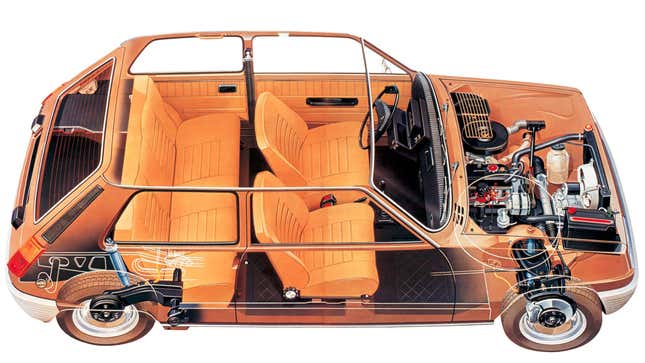
So I was educating myself about the oft-maligned Yugo this morning, as one does, when I discovered an attribute I wasn’t previously aware of: the car’s front-mounted, full-size spare tire.
As one of the younger Jalops on staff, this piqued my interest. My parents never owned a car during my lifetime that stashed the spare in the engine bay. Once upon a time, though, it was a fairly common practice. Naturally, I asked Torch, our arbiter of all clever-yet-outdated automotive design trends, to shed some light on this for me.
Some manufacturers were big fans of the engine bay-mounted spare. Subaru did it a lot in the ’70s and ’80s, as the flat engine configuration allowed enough clearance overhead to fit a whole tire. (In fact, today’s Nice Price Or No Dice Subaru Brat was one such car.) The Citroën Ami, first-generation Fiat Panda and Renault Le Car had their spares sharing space with their engines as well.
The benefit of course was that you got more space in the back, perhaps due to a lower load floor, than you would have otherwise had. And engines back in the day in smaller cars were compact enough to accommodate a tire.
For some brands, it was pitched as a safety feature in addition to a space-saving one. This Yugo training video claimed the placement helped “absorb energy in a frontal impact,” and also further protected the spare from theft. The really clever carmakers even used the air pressure from the spare to pump windshield washer fluid. (Though, obviously in the Beetle’s case, the tire was in the frunk and not with the engine — but you get the idea.)
Front-mounted spares in front-engine cars are all but gone now — which is a little surprising to me. With cars getting progressively larger as engines get smaller, you’d think someone might attempt it again.
The issue — as many critics have pointed out over the years — is that the heat emitted from an engine and the rubber of a tire don’t coexist peacefully. The high temperatures dry the rubber out, rotting it and causing it to crack. Which is fine most of the time until you’re in a situation where you actually need your spare.
If my Fiesta lost the space for the donut in the back — not that it could fit up front or really anywhere else — I might get six more inches of vertical cargo room. That’d be nice, but it’s not going to kill me either way. I’d rather have the tire work when I need it to.
Besides, full electrification gives automakers more freedom to place the tire wherever they want, without an internal-combustion engine eating into potential space. And let’s be honest — with how few cars actually come with spare tires anymore, this isn’t a problem engineers are likely wasting sleep over. Though in the classic Jalopnik tradition against all good sense, I’d just be delighted to see the spares jammed in the engine bay make a comeback — maybe just one time.